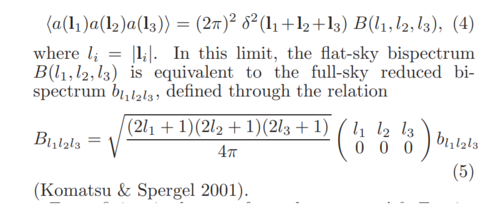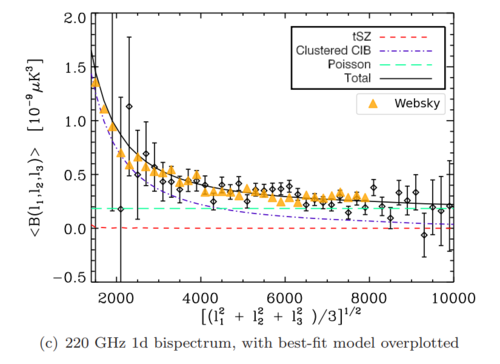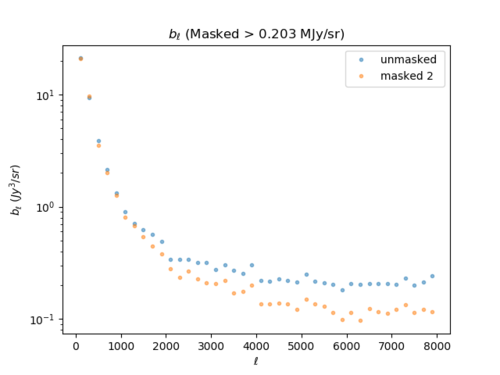Aug 18th, 2019 - CIB Bispectrum: Comparison With Crawford Plot (217GHz, Poisson Part)
I have finally been able to provide a direct comparison of the high [math]\displaystyle{ \ell }[/math] bispectra between the Websky results and the Crawford plot.
The frequency of the Websky map is 217GHz, while the Crawford plot (SPT) shows 220GHz; I compared these two without accounting for the small difference in frequencies for now. The Crawford plot gives the reduced bispectrum in units of [math]\displaystyle{ \mu\text{K}^3 }[/math] while our reduced bispectrum estimator gives the units in [math]\displaystyle{ \text{Jy}^3/\text{sr} }[/math] (matching Planck), so I had to match the units.
According to George's (helpful) figure (https://mocks.cita.utoronto.ca/index.php/File:Conversion_factors.png), 1 Jy/sr corresponds to [math]\displaystyle{ 2.0676 \times 10^{-3} \mu \text{K} }[/math]. Then, [math]\displaystyle{ \text{Jy}^3/\text{sr}^3 = (2.0676 \times 10^{-3})^3 {\mu \text{K}}^3 }[/math]. Here, we take a look at the Crawford et al. (2014) paper's formalism for the bispectrum (https://iopscience.iop.org/article/10.1088/0004-637X/784/2/143/pdf):
Since the left-hand side has a unit of [math]\displaystyle{ [\text{Jy}/\text{sr}^{1/2}]^3 = \text{Jy}^3/\text{sr}^{3/2} }[/math], and [math]\displaystyle{ 2 \pi }[/math] on the right-hand side is in radians ([math]\displaystyle{ \text{rad} ^2 }[/math] corresponds to 'sr'), the [math]\displaystyle{ B(\ell_1, \ell_2, \ell_3) }[/math] mentioned in the equation must have a unit of [math]\displaystyle{ \text{Jy}^3/\text{sr}^{5/2} }[/math]. Since this is exactly the same as [math]\displaystyle{ b_{\ell_1 \ell_2 \ell_3} }[/math] (which I have been using), we must divide our filtered bispectrum by a factor of [math]\displaystyle{ \sqrt{\text{sr}} = \sqrt{4 \pi} }[/math] then multiply by [math]\displaystyle{ 2.0676 \times 10^{-3})^3 }[/math] to obtain the bispectrum values in [math]\displaystyle{ \mu\text{K} }[/math].
The result is as below:
We see that the Websky values and 'Total' values match quite well. (The x-labels are different between the Websky and the Crawford, but this should not make a big difference)
Since I had masked the brightest 20,000 pixels of the 217 CIB map before calculating the reduced bispectrum, it seems that the masking works pretty well, since the Websky values would have been almost twice as large (below) if I had not masked the map.


